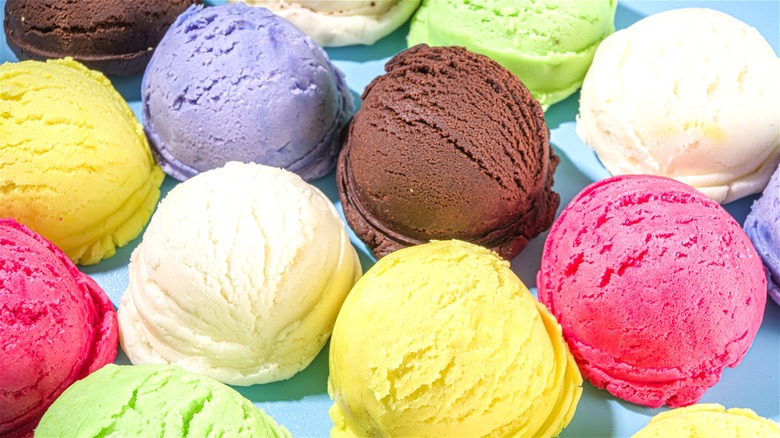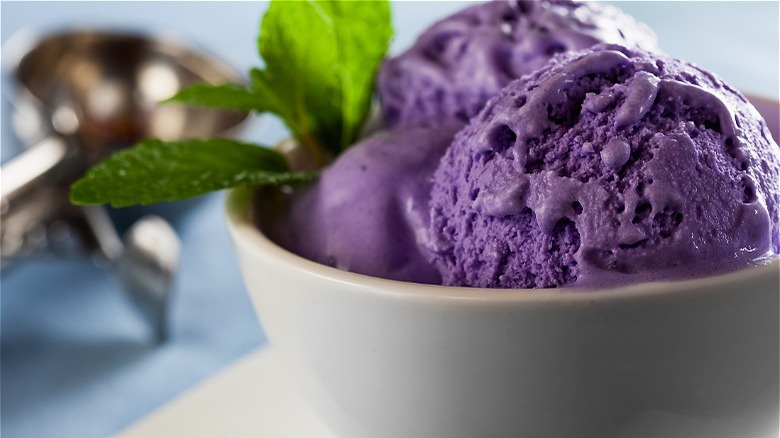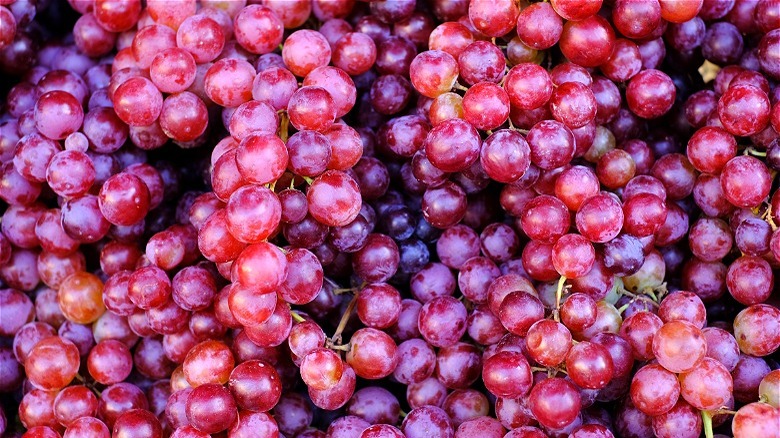Why You Almost Never See Grape Ice Cream (We Are Just Noticing Too)
Ice cream is one of those confections we can assume most people enjoy. In fact, according to a survey conducted by National Today, out of 2,000 participants, 30% had no problem admitting they'd eat ice cream at every meal if it were offered and available for consumption. Since many Americans love ice cream, we are hardly surprised when we see a new wild flavor debut at local confectionaries or grocery stores. Beyond our traditional favorites like classic vanilla and chocolate, you can find pistachio, lavender, and even sweet corn and maple ice cream varieties.
You might think any fresh fruit can pair well with the milky deliciousness of frozen cream and sugar when it comes to fruit-flavored ice creams. After all, cantaloupe ice cream does exist. However, you'll likely never find grape-flavored ice cream among the plethora of fruit-based scoops. While you can find grape-flavored soda and even grape-filled Pop-Tarts, scoring purple-tinged ice cream that tastes of concord grapes is a rarity for more than one reason.
First, grape-flavored ice cream doesn't sound appealing to most people. When you mix this lack of excitement over grape ice cream and combine it with the difficulty of converting grapes into a frozen treat, the resulting product may take more work than it's worth. Let's get into the specifics though: what about grapes makes it so hard to prepare for a cold confection like ice cream?
The scientific explanation for the lack of grape ice cream
Grape-flavored ice cream doesn't have a chance of ever being named one of the most popular ice cream flavors in America because it doesn't exist in cold supermarket cases or local ice cream parlors. Ice cream lovers don't necessarily seek chilled grape-flavored cream, and beyond that, grapes are pretty hard to process.
For one thing, grapes are highly acidic. Food author and chemical engineer Jim Mumford explained to Reader's Digest that unless you take the time to remove the acidic content of these purple orbs, you may end up with an offset mixture that tends to turn sour faster. The process of extracting this acidic juice can be pretty time-consuming. It is also a reasonably uncommon procedure considering many other fruit-flavored ice creams don't have to undergo this process.
Additionally, a compound within grapes called anthocyanin, responsible for that rich purple color, is quite fragile. One 2021 study shows anthocyanins change when environmental changes occur in light, temperature, and pH variance. Processing grapes, extracting their acidic juice, and then freezing them are all significant changes made to the fruit's chemical makeup, which may degrade its natural color and flavor. This may force processors to use artificial dyes and flavors to achieve that signature grape flavor. While grapes' acidic content and color play significant parts in this equation, their water content is also worth considering.
Grapes are high in water (but so are a lot of other fruits)
Even though grapes may not be the one food that is as hydrating as a glass of water, they come with a significant amount. Grapes are over 80% water which means, unfortunately, when you freeze them unless completely processed into a smooth consistency, you will end up with small hunks of icy grapes in your favorite frozen dessert. Yet, what about all the other fruits primarily made of water that can still be processed into ice cream?
Blueberries, raspberries, and peaches have comparable water content to grapes, yet they have become popular ice cream varieties. The reason for this is that not many people desire grape ice cream but welcome the flavors of traditional berries and cream. The concept of grape and dairy has not been a flavor that foodies actively crave. Therefore, many companies don't put forth the effort for grapes as they do for other hydrating fruits.
Furthermore, food author Ja-ne de Abreu explains to Reader's Digest how grapes are also tricky to work with when trying to produce a uniform product: While no one wants to find slivers of frozen grape skin in their ice cream, the skins house the most flavor. With all of these factors considered, there's sound reasoning behind the absence of grape ice cream. And let's be honest, does it even sound good?


